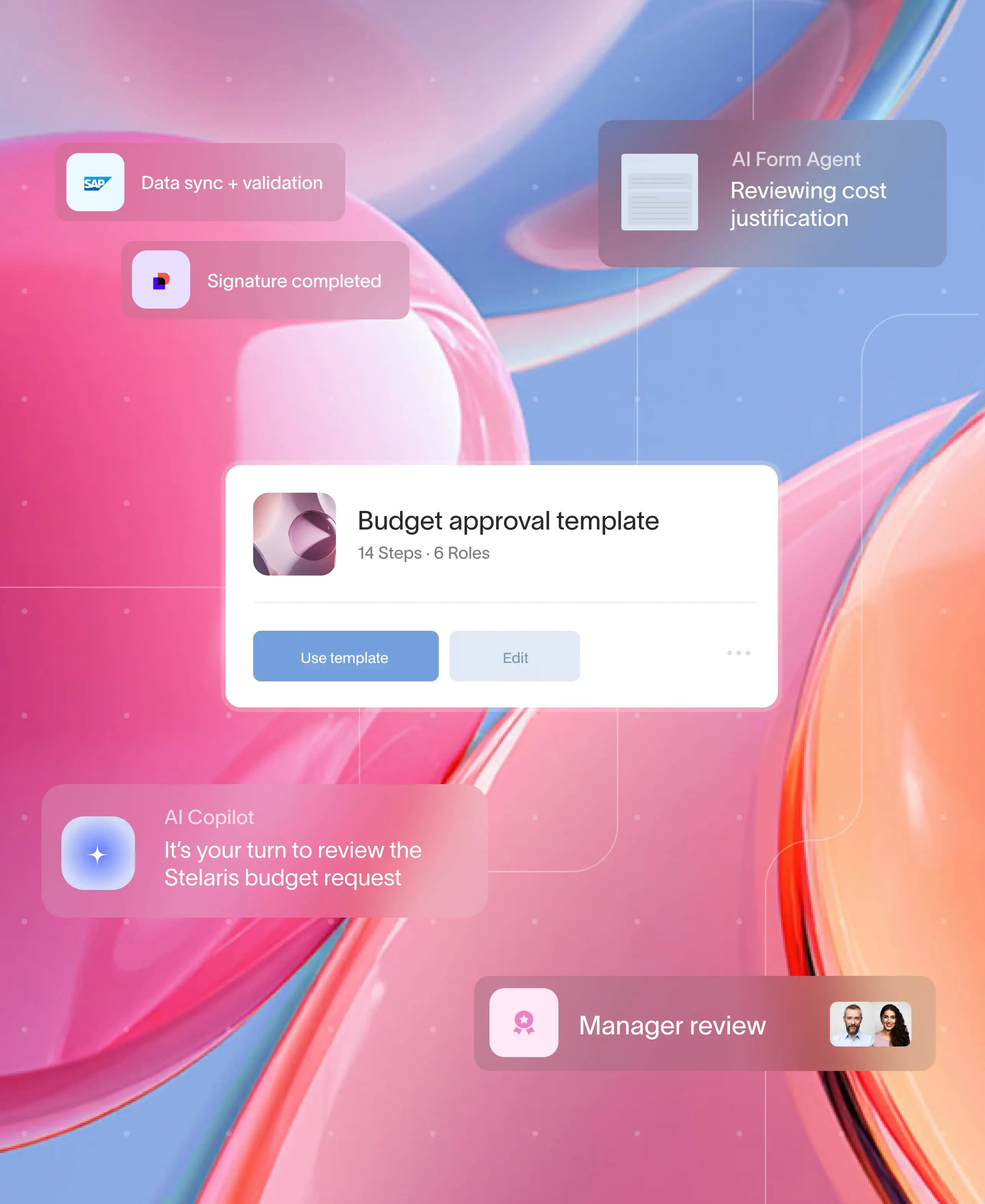
Collaboration at enterprises is complex and intricate. Teams operate across departments, partners span multiple organizations, and clients expect fast, frictionless experiences. Without a centralized way to manage these interactions, work becomes fragmented, and progress stalls.
Disparate tools and solutions cause chaos and inefficiencies. Siloed email threads, scattered documents, and disconnected platforms lead to delays, confusion, and missed expectations. For businesses aiming to scale efficiently and deliver consistent results, this creates a serious operational gap.
An enterprise collaboration system fills that gap. It unifies communication, workflow management, and task execution within a single platform, enabling teams to move faster, clients to stay engaged, and organizations to maintain control over complex service delivery.
This blog outlines what enterprise collaboration means, the essential features of collaboration systems for enterprises, how they benefit growing organizations, and how Moxo’s service orchestration platform streamlines enterprise collaboration without the complexity.
What is an enterprise collaboration system
An enterprise collaboration system is a digital platform designed to centralize how teams, departments, and external stakeholders communicate, manage tasks, and execute workflows. Unlike simple messaging tools or document storage systems, an enterprise collaboration system integrates these functions to support seamless, real-time coordination across complex business processes.
At its core, enterprise collaboration is about enabling everyone to work together effectively – whether they’re across the hall or the globe. It eliminates communication silos, organizes work around shared goals, and ensures that teams can execute with clarity, accountability, and speed.
Enterprise collaboration systems are valuable for organizations managing high-touch client engagements, multi-party workflows, or long-running service delivery processes. By bringing every participant into a shared digital environment, an enterprise collaboration system reduces friction and accelerates execution.
Key features of an enterprise collaboration system
Understanding the features of an enterprise collaboration system helps clarify why these platforms are so powerful. While capabilities can vary by provider, the most effective systems include:
- Centralized communication: Messaging, video calls, and file sharing are housed in one hub, with context tied to each interaction.
- Task and workflow management: Assignments, due dates, and process flow are clearly defined and trackable for every stakeholder.
- Client and external party collaboration: Tools that enable secure, controlled access for clients, vendors, or partners.
- Document control and e-signature: Version tracking, approval workflows, and embedded signing for sensitive documents.
- Notifications and reminders: Automated nudges to keep stakeholders on track and eliminate follow-up fatigue.
- Audit trails and visibility: Full transparency into who did what and when to maintain accountability and compliance.
- Integration with existing systems: Connectivity with CRMs, ERPs, file storage tools, and other critical platforms.
These features work together to support a single goal: helping enterprises execute scalable workflows.
How enterprise collaboration systems deliver real business impact
Implementing an enterprise collaboration system is not just about improving communication. It’s about transforming how work gets done. When teams, clients, and partners operate in a unified digital environment, the ripple effects are felt across the organization.
Here are the most significant benefits of adopting an enterprise collaboration system:
1. Improved communication across all stakeholders
An ECS provides a centralized space for communication, reducing scattered email threads and missed messages. Conversations happen in context within specific tasks, projects, or workflows so nothing gets lost and everyone stays aligned.
2. Enhanced internal and external collaboration
Whether it’s cross-functional teams or external stakeholders like clients and vendors, collaboration becomes seamless. Enterprise collaboration systems enable controlled access, shared task views, and transparent updates, creating a smooth, coordinated experience for everyone involved.
3. Increased productivity through workflow orchestration
When tasks, files, and conversations live in one space, teams spend less time searching and more time executing. Automated workflows ensure that processes move forward without manual follow-ups, freeing up time for higher-value work.
4. Streamlined processes and reduced bottlenecks
An enterprise collaboration system removes ambiguity from complex processes. With clear task ownership, built-in accountability, and automated routing, work progresses without unnecessary delays. Dependencies are transparent, making it easier to identify and resolve blockers early.
5. Better knowledge management
Documents, notes, and communication histories are stored in organized workspaces with complete audit trails. Institutional knowledge is preserved and accessible, so team members don’t lose momentum due to missing context or staff transitions.
6. Improved client satisfaction
A well-implemented enterprise collaboration system enhances the client experience by making collaboration more responsive, transparent, and secure. Clients stay informed, have a clear line of communication, and are never left wondering about the next steps.
7. Reduced operational costs
By unifying multiple tools into a single platform and reducing inefficiencies caused by miscommunication or delays, enterprise collaboration systems help lower operational overhead. The result is a leaner, more agile organization.
Together, these benefits create a foundation for sustainable growth, helping enterprises operate with greater precision, speed, and confidence in every client and team interaction.
How Moxo streamlines enterprise collaboration at scale
Enterprise collaboration systems are only effective when they fit seamlessly into the way a business already operates. Many platforms promise powerful features but require complex setups, multiple integrations, or ongoing IT involvement to maintain. Moxo takes a different approach.
As a service orchestration platform, Moxo is purpose-built to streamline collaboration across internal teams and external stakeholders – without adding operational overhead. It enables businesses to structure and automate multi-step workflows, manage high-touch interactions, and centralize communication in a secure, branded environment.
Moxo’s interface is designed for clarity. Stakeholders, whether internal employees or clients, interact through guided flows that keep processes moving without confusion. Tasks are assigned, documents are signed, and messages are exchanged, all within a single, context-rich workspace.
For organizations looking to eliminate the friction of fragmented systems, Moxo provides a unified experience. It transforms enterprise collaboration from reactive to orchestrated, with every interaction, task, and milestone part of a coordinated process.
How to implement an enterprise collaboration system with Moxo
Rolling out an enterprise collaboration system doesn’t need to be a long, complicated transformation. With Moxo, businesses can implement a structured collaboration experience quickly and with minimal disruption. Here’s a step-by-step look at how implementation works.
Step 1: Map your key service workflows
Start by identifying the business processes that involve multi-party collaboration – client onboarding, project execution, vendor coordination, account servicing, or any other process where handoffs happen. Define the steps, roles, and key touchpoints involved.
Step 2: Build Flow templates in Moxo
Use Moxo’s Workflow Builder to translate your service processes into structured, digital workspaces. Assign roles, add checklist items, set task dependencies, upload documents, and define approval points. Each flow becomes a repeatable blueprint for how work gets done.
Step 3: Customize client-facing experiences
Brand the client portal with your company’s logo, color palette, and tone. Tailor the interface to your clients’ expectations, ensuring they interact with your organization through a polished, professional experience. Add guided instructions, timelines, and points of contact for transparency.
Step 4: Invite internal teams and external stakeholders
Onboard your internal team members, then extend access to clients, partners, or vendors as needed. Roles and permissions ensure everyone sees only what’s relevant to them, helping maintain clarity and control throughout the workflow.
Step 5: Launch your flows and go live
Once your flow workspace is configured, you’re ready to launch. Moxo makes it easy to initiate new client or project flows from templates. This keeps every engagement organized from day one. Built-in notifications and automation keep everything on track.
Step 6: Monitor, optimize, and scale
Use Moxo’s activity tracking, audit trails, and reporting tools to monitor performance and identify opportunities for optimization. As your needs evolve, you can duplicate or adjust flows to support new service lines or teams, scaling your collaboration system without disruption.
This step-by-step process allows businesses to move from siloed communication to orchestrated execution without needing a dedicated IT overhaul or months of system training. Get started to streamline your enterprise collaboration with Moxo.
Overcoming enterprise collaboration challenges with Moxo
Adopting an enterprise collaboration system can transform operations—but not without hurdles. Teams may resist change, legacy systems complicate integration, and security and scalability are ongoing concerns. Moxo is purpose-built to address these common challenges, streamlining adoption and enabling long-term success.
- Intuitive user experience: Moxo’s clean, mobile-friendly interface minimizes friction. Guided flows and branded portals help both teams and clients understand next steps, reducing the learning curve and boosting adoption from day one.
- Seamless integration: Moxo connects with existing CRMs, storage tools, and platforms via APIs and webhooks, ensuring continuity across your tech stack without forcing system overhauls.
- Enterprise-grade security: With encryption, access controls, audit trails, and compliance support, Moxo enables secure collaboration that meets industry regulations.
- Ongoing enablement: Businesses receive onboarding support, documentation, and templates to maintain momentum post-launch. Best-practice guidance ensures teams are equipped to use the platform effectively.
- Scalable architecture: Moxo’s flexible flow framework makes it easy to replicate and evolve processes as teams grow or service lines expand—without adding complexity or disrupting current operations.
By simplifying adoption, enhancing security, and supporting scale, Moxo helps enterprises turn collaboration from a challenge into a competitive advantage.
Conclusion
Enterprise collaboration requires more than chat tools or shared drives. As teams manage complex processes across departments, clients, and partners, there’s a growing need for systems that support structured, repeatable workflows.
An enterprise collaboration system provides a centralized way to manage communication, task execution, document exchange, and external interactions. It helps organizations reduce friction, improve coordination, and deliver consistent outcomes.
Moxo’s service orchestration platform allows enterprises to build and manage collaborative workflows with control and clarity. Teams stay aligned, clients stay informed, and service delivery becomes more efficient.
By implementing an enterprise collaboration system with Moxo, businesses can move work forward with less overhead, fewer delays, and greater accountability. Get started to streamline your enterprise collaboration with Moxo.
FAQs
How is an enterprise collaboration system different from a project management tool?
Project management tools focus on task tracking and internal team coordination. Enterprise collaboration systems support broader workflows that include communication, document exchange, and coordination with external stakeholders like clients, vendors, and partners.
Can an enterprise collaboration system support compliance and audit requirements?
Yes. Many enterprise collaboration systems include features such as audit logs, permission controls, data retention policies, and role-based access that support compliance in industries like finance, healthcare, and legal services.
Is onboarding clients or vendors part of what an enterprise collaboration system handles?
Absolutely. Enterprise collaboration systems are often used to orchestrate onboarding processes that require multiple steps, document collection, task assignments, and ongoing communication all in one place.
What type of businesses benefit most from enterprise collaboration systems?
Enterprises with complex service delivery models, distributed teams, or multi-party workflows gain the most value. This includes firms in financial services, consulting, legal, technology, logistics, and other relationship-driven industries.





